MGT602 Reflective Report on Business Decision Analytics and Style
VerifiedAdded on 2022/11/28
|9
|1837
|401
Report
AI Summary
This report reflects on business decision analytics, focusing on decision-making styles and their impact within a professional setting. The author, an HR manager at Commonwealth Bank, discusses decisions made regarding employee retention policies and the implementation of a positive workplace culture. The report delves into decision-making preferences, the influence of personality styles (particularly the 'sense-maker' personality), and biases that can affect judgment. Feedbacks from colleagues are considered, along with the evaluation of decisions through journey mapping and rational processing models. The report also integrates visual data mining and statistical models to enhance decision-making, referencing relevant theories and research. The aim is to improve recruitment and selection processes within the bank by understanding and mitigating potential biases and improving data-driven strategies.
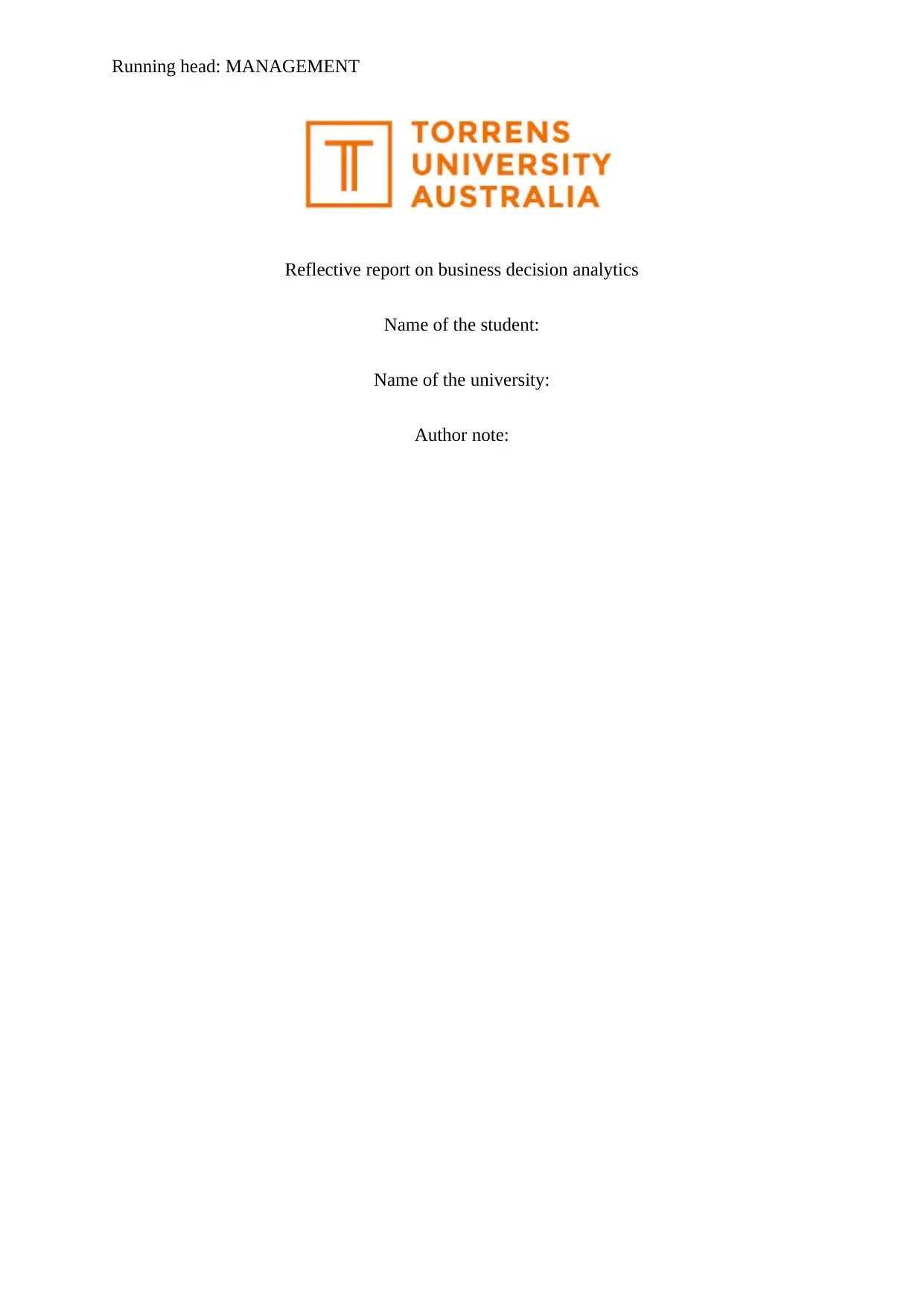
Running head: MANAGEMENT
Reflective report on business decision analytics
Name of the student:
Name of the university:
Author note:
Reflective report on business decision analytics
Name of the student:
Name of the university:
Author note:
Paraphrase This Document
Need a fresh take? Get an instant paraphrase of this document with our AI Paraphraser
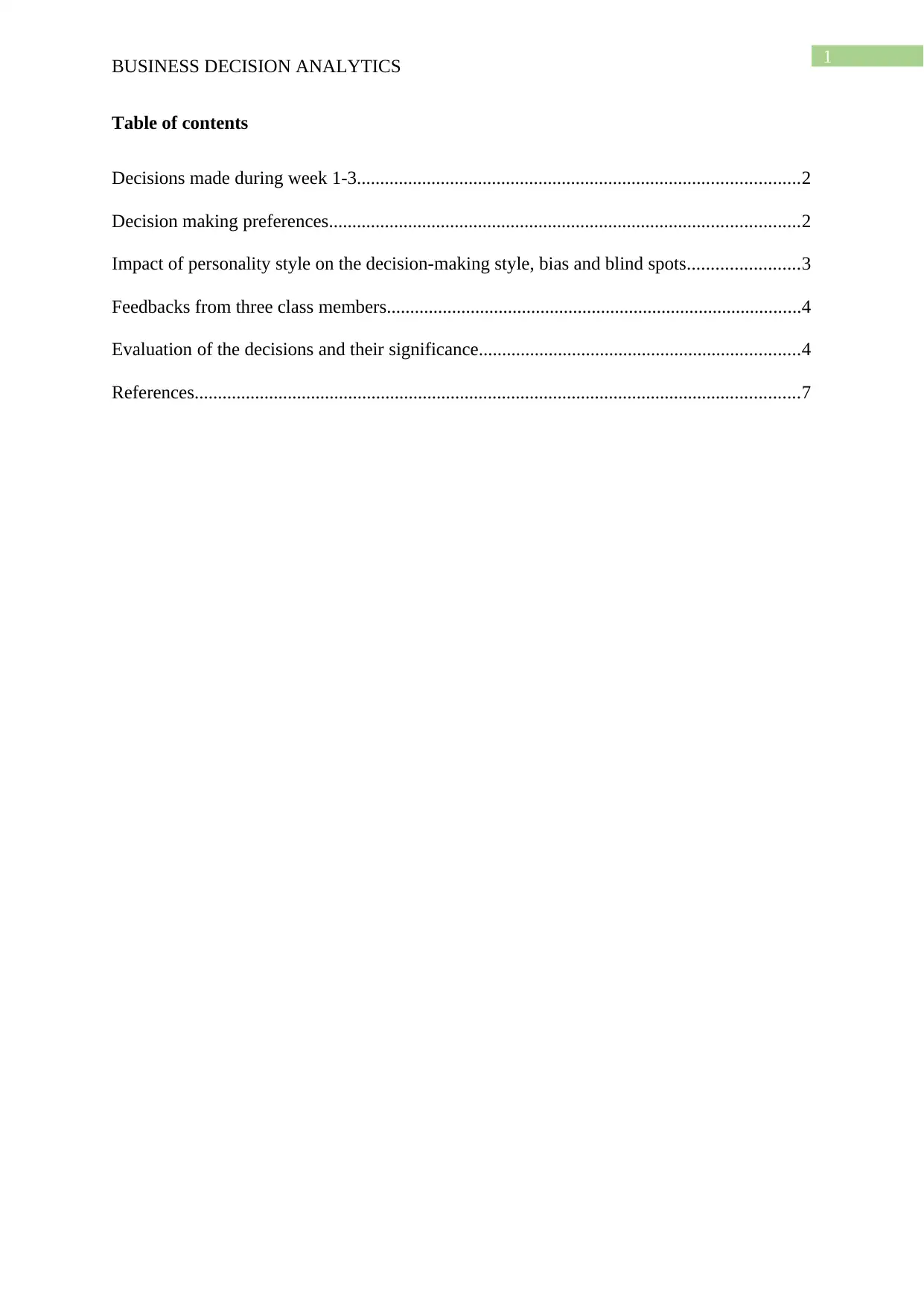
1
BUSINESS DECISION ANALYTICS
Table of contents
Decisions made during week 1-3...............................................................................................2
Decision making preferences.....................................................................................................2
Impact of personality style on the decision-making style, bias and blind spots........................3
Feedbacks from three class members.........................................................................................4
Evaluation of the decisions and their significance.....................................................................4
References..................................................................................................................................7
BUSINESS DECISION ANALYTICS
Table of contents
Decisions made during week 1-3...............................................................................................2
Decision making preferences.....................................................................................................2
Impact of personality style on the decision-making style, bias and blind spots........................3
Feedbacks from three class members.........................................................................................4
Evaluation of the decisions and their significance.....................................................................4
References..................................................................................................................................7
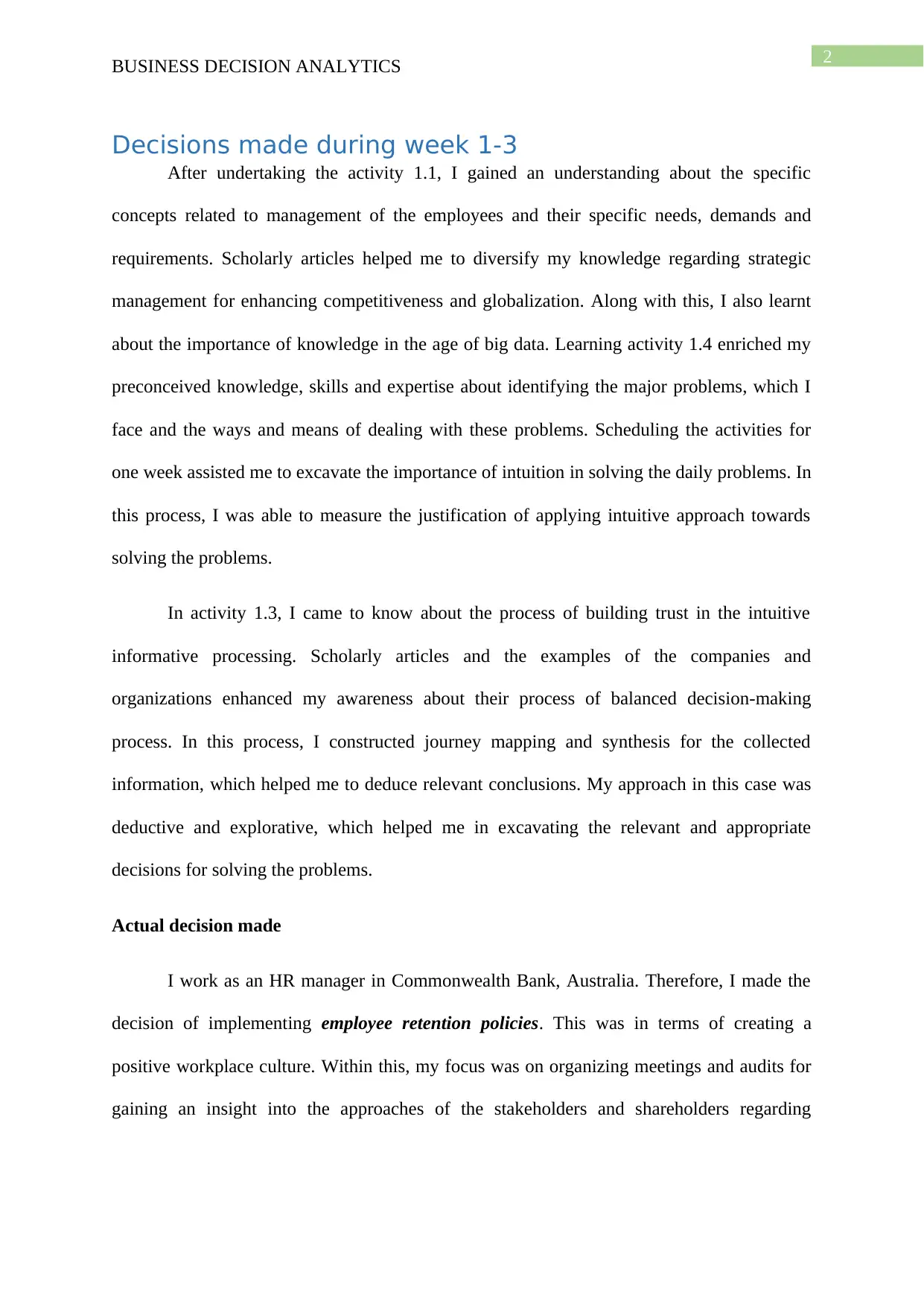
2
BUSINESS DECISION ANALYTICS
Decisions made during week 1-3
After undertaking the activity 1.1, I gained an understanding about the specific
concepts related to management of the employees and their specific needs, demands and
requirements. Scholarly articles helped me to diversify my knowledge regarding strategic
management for enhancing competitiveness and globalization. Along with this, I also learnt
about the importance of knowledge in the age of big data. Learning activity 1.4 enriched my
preconceived knowledge, skills and expertise about identifying the major problems, which I
face and the ways and means of dealing with these problems. Scheduling the activities for
one week assisted me to excavate the importance of intuition in solving the daily problems. In
this process, I was able to measure the justification of applying intuitive approach towards
solving the problems.
In activity 1.3, I came to know about the process of building trust in the intuitive
informative processing. Scholarly articles and the examples of the companies and
organizations enhanced my awareness about their process of balanced decision-making
process. In this process, I constructed journey mapping and synthesis for the collected
information, which helped me to deduce relevant conclusions. My approach in this case was
deductive and explorative, which helped me in excavating the relevant and appropriate
decisions for solving the problems.
Actual decision made
I work as an HR manager in Commonwealth Bank, Australia. Therefore, I made the
decision of implementing employee retention policies. This was in terms of creating a
positive workplace culture. Within this, my focus was on organizing meetings and audits for
gaining an insight into the approaches of the stakeholders and shareholders regarding
BUSINESS DECISION ANALYTICS
Decisions made during week 1-3
After undertaking the activity 1.1, I gained an understanding about the specific
concepts related to management of the employees and their specific needs, demands and
requirements. Scholarly articles helped me to diversify my knowledge regarding strategic
management for enhancing competitiveness and globalization. Along with this, I also learnt
about the importance of knowledge in the age of big data. Learning activity 1.4 enriched my
preconceived knowledge, skills and expertise about identifying the major problems, which I
face and the ways and means of dealing with these problems. Scheduling the activities for
one week assisted me to excavate the importance of intuition in solving the daily problems. In
this process, I was able to measure the justification of applying intuitive approach towards
solving the problems.
In activity 1.3, I came to know about the process of building trust in the intuitive
informative processing. Scholarly articles and the examples of the companies and
organizations enhanced my awareness about their process of balanced decision-making
process. In this process, I constructed journey mapping and synthesis for the collected
information, which helped me to deduce relevant conclusions. My approach in this case was
deductive and explorative, which helped me in excavating the relevant and appropriate
decisions for solving the problems.
Actual decision made
I work as an HR manager in Commonwealth Bank, Australia. Therefore, I made the
decision of implementing employee retention policies. This was in terms of creating a
positive workplace culture. Within this, my focus was on organizing meetings and audits for
gaining an insight into the approaches of the stakeholders and shareholders regarding
⊘ This is a preview!⊘
Do you want full access?
Subscribe today to unlock all pages.

Trusted by 1+ million students worldwide
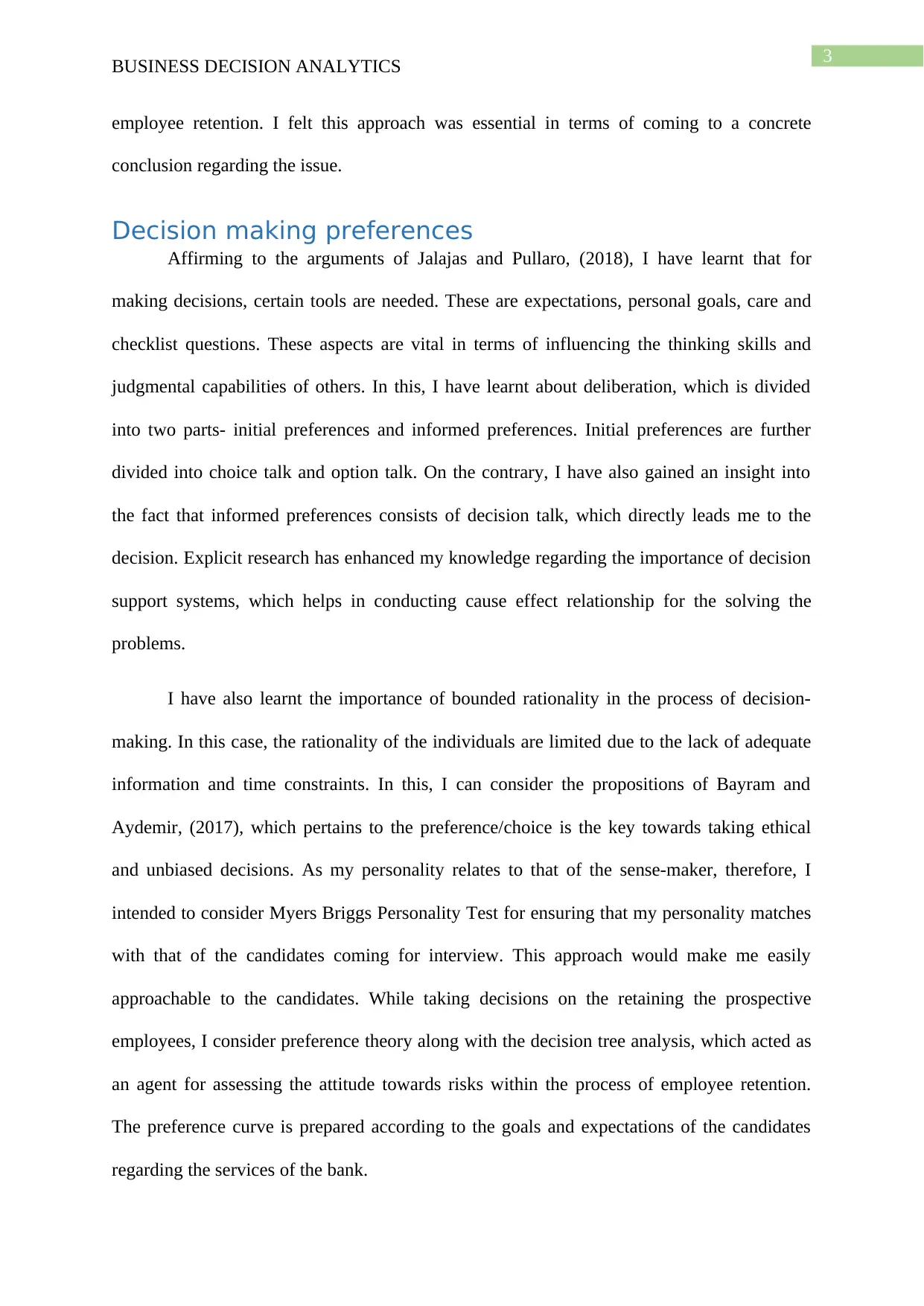
3
BUSINESS DECISION ANALYTICS
employee retention. I felt this approach was essential in terms of coming to a concrete
conclusion regarding the issue.
Decision making preferences
Affirming to the arguments of Jalajas and Pullaro, (2018), I have learnt that for
making decisions, certain tools are needed. These are expectations, personal goals, care and
checklist questions. These aspects are vital in terms of influencing the thinking skills and
judgmental capabilities of others. In this, I have learnt about deliberation, which is divided
into two parts- initial preferences and informed preferences. Initial preferences are further
divided into choice talk and option talk. On the contrary, I have also gained an insight into
the fact that informed preferences consists of decision talk, which directly leads me to the
decision. Explicit research has enhanced my knowledge regarding the importance of decision
support systems, which helps in conducting cause effect relationship for the solving the
problems.
I have also learnt the importance of bounded rationality in the process of decision-
making. In this case, the rationality of the individuals are limited due to the lack of adequate
information and time constraints. In this, I can consider the propositions of Bayram and
Aydemir, (2017), which pertains to the preference/choice is the key towards taking ethical
and unbiased decisions. As my personality relates to that of the sense-maker, therefore, I
intended to consider Myers Briggs Personality Test for ensuring that my personality matches
with that of the candidates coming for interview. This approach would make me easily
approachable to the candidates. While taking decisions on the retaining the prospective
employees, I consider preference theory along with the decision tree analysis, which acted as
an agent for assessing the attitude towards risks within the process of employee retention.
The preference curve is prepared according to the goals and expectations of the candidates
regarding the services of the bank.
BUSINESS DECISION ANALYTICS
employee retention. I felt this approach was essential in terms of coming to a concrete
conclusion regarding the issue.
Decision making preferences
Affirming to the arguments of Jalajas and Pullaro, (2018), I have learnt that for
making decisions, certain tools are needed. These are expectations, personal goals, care and
checklist questions. These aspects are vital in terms of influencing the thinking skills and
judgmental capabilities of others. In this, I have learnt about deliberation, which is divided
into two parts- initial preferences and informed preferences. Initial preferences are further
divided into choice talk and option talk. On the contrary, I have also gained an insight into
the fact that informed preferences consists of decision talk, which directly leads me to the
decision. Explicit research has enhanced my knowledge regarding the importance of decision
support systems, which helps in conducting cause effect relationship for the solving the
problems.
I have also learnt the importance of bounded rationality in the process of decision-
making. In this case, the rationality of the individuals are limited due to the lack of adequate
information and time constraints. In this, I can consider the propositions of Bayram and
Aydemir, (2017), which pertains to the preference/choice is the key towards taking ethical
and unbiased decisions. As my personality relates to that of the sense-maker, therefore, I
intended to consider Myers Briggs Personality Test for ensuring that my personality matches
with that of the candidates coming for interview. This approach would make me easily
approachable to the candidates. While taking decisions on the retaining the prospective
employees, I consider preference theory along with the decision tree analysis, which acted as
an agent for assessing the attitude towards risks within the process of employee retention.
The preference curve is prepared according to the goals and expectations of the candidates
regarding the services of the bank.
Paraphrase This Document
Need a fresh take? Get an instant paraphrase of this document with our AI Paraphraser
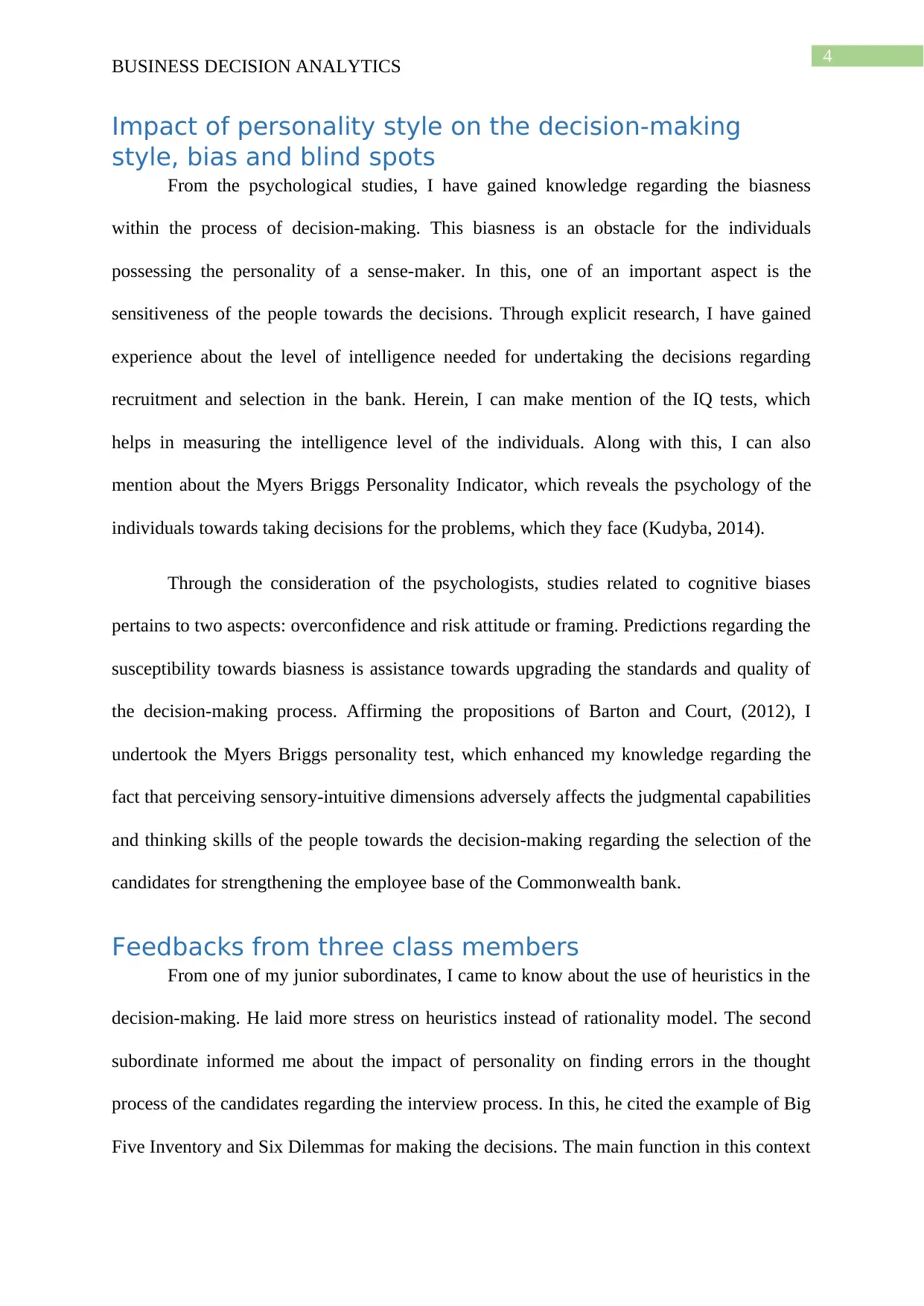
4
BUSINESS DECISION ANALYTICS
Impact of personality style on the decision-making
style, bias and blind spots
From the psychological studies, I have gained knowledge regarding the biasness
within the process of decision-making. This biasness is an obstacle for the individuals
possessing the personality of a sense-maker. In this, one of an important aspect is the
sensitiveness of the people towards the decisions. Through explicit research, I have gained
experience about the level of intelligence needed for undertaking the decisions regarding
recruitment and selection in the bank. Herein, I can make mention of the IQ tests, which
helps in measuring the intelligence level of the individuals. Along with this, I can also
mention about the Myers Briggs Personality Indicator, which reveals the psychology of the
individuals towards taking decisions for the problems, which they face (Kudyba, 2014).
Through the consideration of the psychologists, studies related to cognitive biases
pertains to two aspects: overconfidence and risk attitude or framing. Predictions regarding the
susceptibility towards biasness is assistance towards upgrading the standards and quality of
the decision-making process. Affirming the propositions of Barton and Court, (2012), I
undertook the Myers Briggs personality test, which enhanced my knowledge regarding the
fact that perceiving sensory-intuitive dimensions adversely affects the judgmental capabilities
and thinking skills of the people towards the decision-making regarding the selection of the
candidates for strengthening the employee base of the Commonwealth bank.
Feedbacks from three class members
From one of my junior subordinates, I came to know about the use of heuristics in the
decision-making. He laid more stress on heuristics instead of rationality model. The second
subordinate informed me about the impact of personality on finding errors in the thought
process of the candidates regarding the interview process. In this, he cited the example of Big
Five Inventory and Six Dilemmas for making the decisions. The main function in this context
BUSINESS DECISION ANALYTICS
Impact of personality style on the decision-making
style, bias and blind spots
From the psychological studies, I have gained knowledge regarding the biasness
within the process of decision-making. This biasness is an obstacle for the individuals
possessing the personality of a sense-maker. In this, one of an important aspect is the
sensitiveness of the people towards the decisions. Through explicit research, I have gained
experience about the level of intelligence needed for undertaking the decisions regarding
recruitment and selection in the bank. Herein, I can make mention of the IQ tests, which
helps in measuring the intelligence level of the individuals. Along with this, I can also
mention about the Myers Briggs Personality Indicator, which reveals the psychology of the
individuals towards taking decisions for the problems, which they face (Kudyba, 2014).
Through the consideration of the psychologists, studies related to cognitive biases
pertains to two aspects: overconfidence and risk attitude or framing. Predictions regarding the
susceptibility towards biasness is assistance towards upgrading the standards and quality of
the decision-making process. Affirming the propositions of Barton and Court, (2012), I
undertook the Myers Briggs personality test, which enhanced my knowledge regarding the
fact that perceiving sensory-intuitive dimensions adversely affects the judgmental capabilities
and thinking skills of the people towards the decision-making regarding the selection of the
candidates for strengthening the employee base of the Commonwealth bank.
Feedbacks from three class members
From one of my junior subordinates, I came to know about the use of heuristics in the
decision-making. He laid more stress on heuristics instead of rationality model. The second
subordinate informed me about the impact of personality on finding errors in the thought
process of the candidates regarding the interview process. In this, he cited the example of Big
Five Inventory and Six Dilemmas for making the decisions. The main function in this context
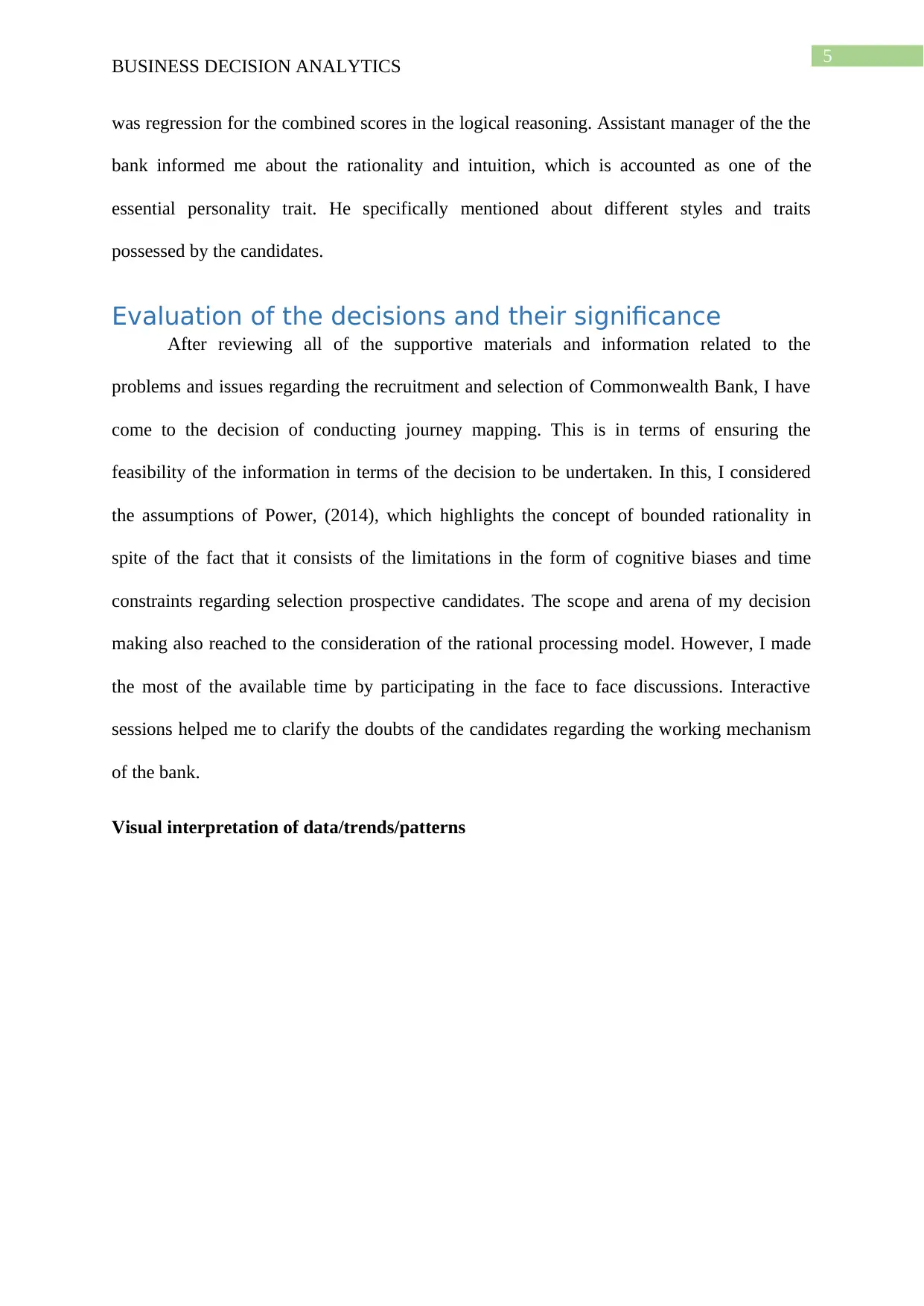
5
BUSINESS DECISION ANALYTICS
was regression for the combined scores in the logical reasoning. Assistant manager of the the
bank informed me about the rationality and intuition, which is accounted as one of the
essential personality trait. He specifically mentioned about different styles and traits
possessed by the candidates.
Evaluation of the decisions and their significance
After reviewing all of the supportive materials and information related to the
problems and issues regarding the recruitment and selection of Commonwealth Bank, I have
come to the decision of conducting journey mapping. This is in terms of ensuring the
feasibility of the information in terms of the decision to be undertaken. In this, I considered
the assumptions of Power, (2014), which highlights the concept of bounded rationality in
spite of the fact that it consists of the limitations in the form of cognitive biases and time
constraints regarding selection prospective candidates. The scope and arena of my decision
making also reached to the consideration of the rational processing model. However, I made
the most of the available time by participating in the face to face discussions. Interactive
sessions helped me to clarify the doubts of the candidates regarding the working mechanism
of the bank.
Visual interpretation of data/trends/patterns
BUSINESS DECISION ANALYTICS
was regression for the combined scores in the logical reasoning. Assistant manager of the the
bank informed me about the rationality and intuition, which is accounted as one of the
essential personality trait. He specifically mentioned about different styles and traits
possessed by the candidates.
Evaluation of the decisions and their significance
After reviewing all of the supportive materials and information related to the
problems and issues regarding the recruitment and selection of Commonwealth Bank, I have
come to the decision of conducting journey mapping. This is in terms of ensuring the
feasibility of the information in terms of the decision to be undertaken. In this, I considered
the assumptions of Power, (2014), which highlights the concept of bounded rationality in
spite of the fact that it consists of the limitations in the form of cognitive biases and time
constraints regarding selection prospective candidates. The scope and arena of my decision
making also reached to the consideration of the rational processing model. However, I made
the most of the available time by participating in the face to face discussions. Interactive
sessions helped me to clarify the doubts of the candidates regarding the working mechanism
of the bank.
Visual interpretation of data/trends/patterns
⊘ This is a preview!⊘
Do you want full access?
Subscribe today to unlock all pages.

Trusted by 1+ million students worldwide
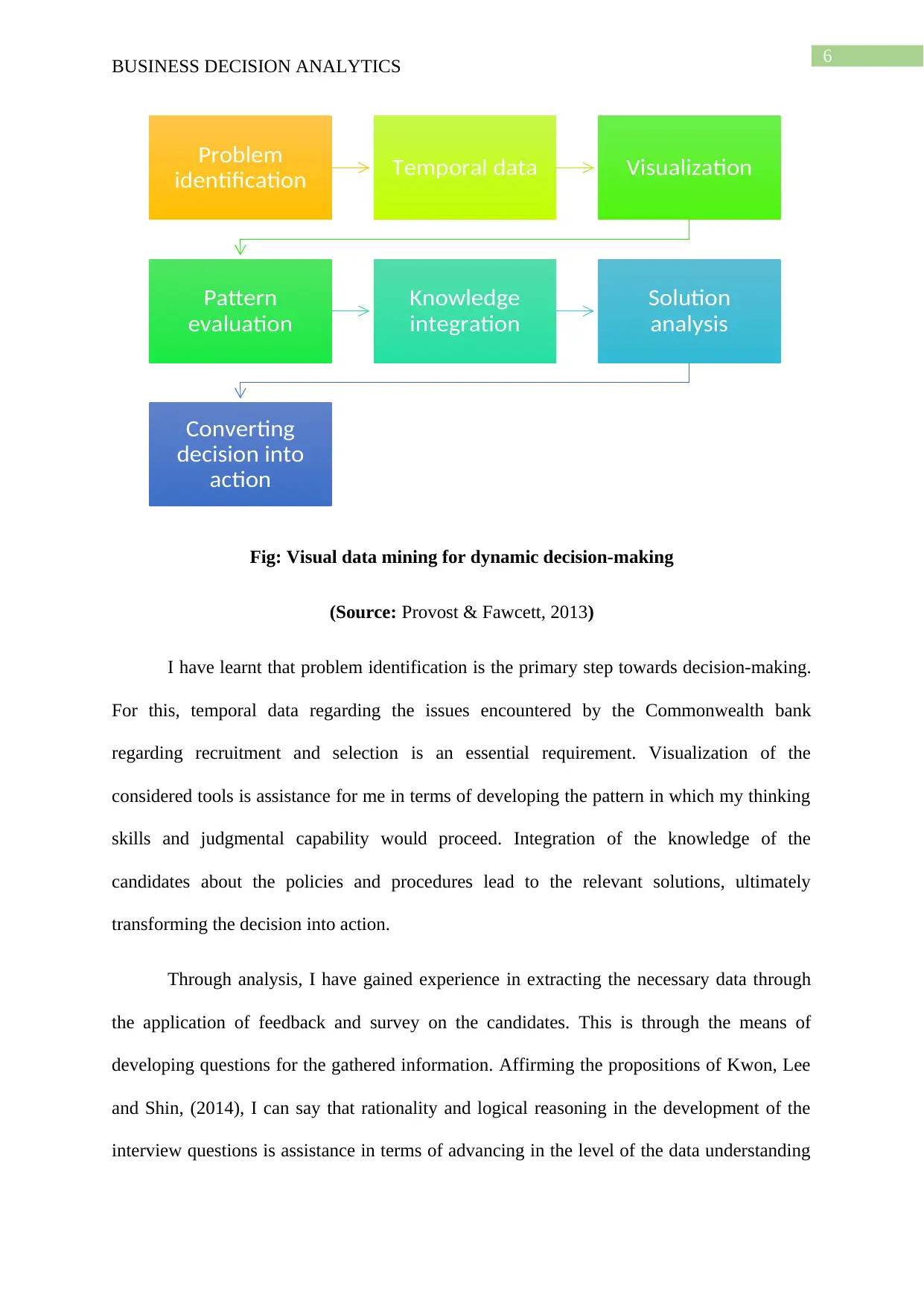
6
BUSINESS DECISION ANALYTICS
Fig: Visual data mining for dynamic decision-making
(Source: Provost & Fawcett, 2013)
I have learnt that problem identification is the primary step towards decision-making.
For this, temporal data regarding the issues encountered by the Commonwealth bank
regarding recruitment and selection is an essential requirement. Visualization of the
considered tools is assistance for me in terms of developing the pattern in which my thinking
skills and judgmental capability would proceed. Integration of the knowledge of the
candidates about the policies and procedures lead to the relevant solutions, ultimately
transforming the decision into action.
Through analysis, I have gained experience in extracting the necessary data through
the application of feedback and survey on the candidates. This is through the means of
developing questions for the gathered information. Affirming the propositions of Kwon, Lee
and Shin, (2014), I can say that rationality and logical reasoning in the development of the
interview questions is assistance in terms of advancing in the level of the data understanding
Problem
identification Temporal data Visualization
Pattern
evaluation
Knowledge
integration
Solution
analysis
Converting
decision into
action
BUSINESS DECISION ANALYTICS
Fig: Visual data mining for dynamic decision-making
(Source: Provost & Fawcett, 2013)
I have learnt that problem identification is the primary step towards decision-making.
For this, temporal data regarding the issues encountered by the Commonwealth bank
regarding recruitment and selection is an essential requirement. Visualization of the
considered tools is assistance for me in terms of developing the pattern in which my thinking
skills and judgmental capability would proceed. Integration of the knowledge of the
candidates about the policies and procedures lead to the relevant solutions, ultimately
transforming the decision into action.
Through analysis, I have gained experience in extracting the necessary data through
the application of feedback and survey on the candidates. This is through the means of
developing questions for the gathered information. Affirming the propositions of Kwon, Lee
and Shin, (2014), I can say that rationality and logical reasoning in the development of the
interview questions is assistance in terms of advancing in the level of the data understanding
Problem
identification Temporal data Visualization
Pattern
evaluation
Knowledge
integration
Solution
analysis
Converting
decision into
action
Paraphrase This Document
Need a fresh take? Get an instant paraphrase of this document with our AI Paraphraser
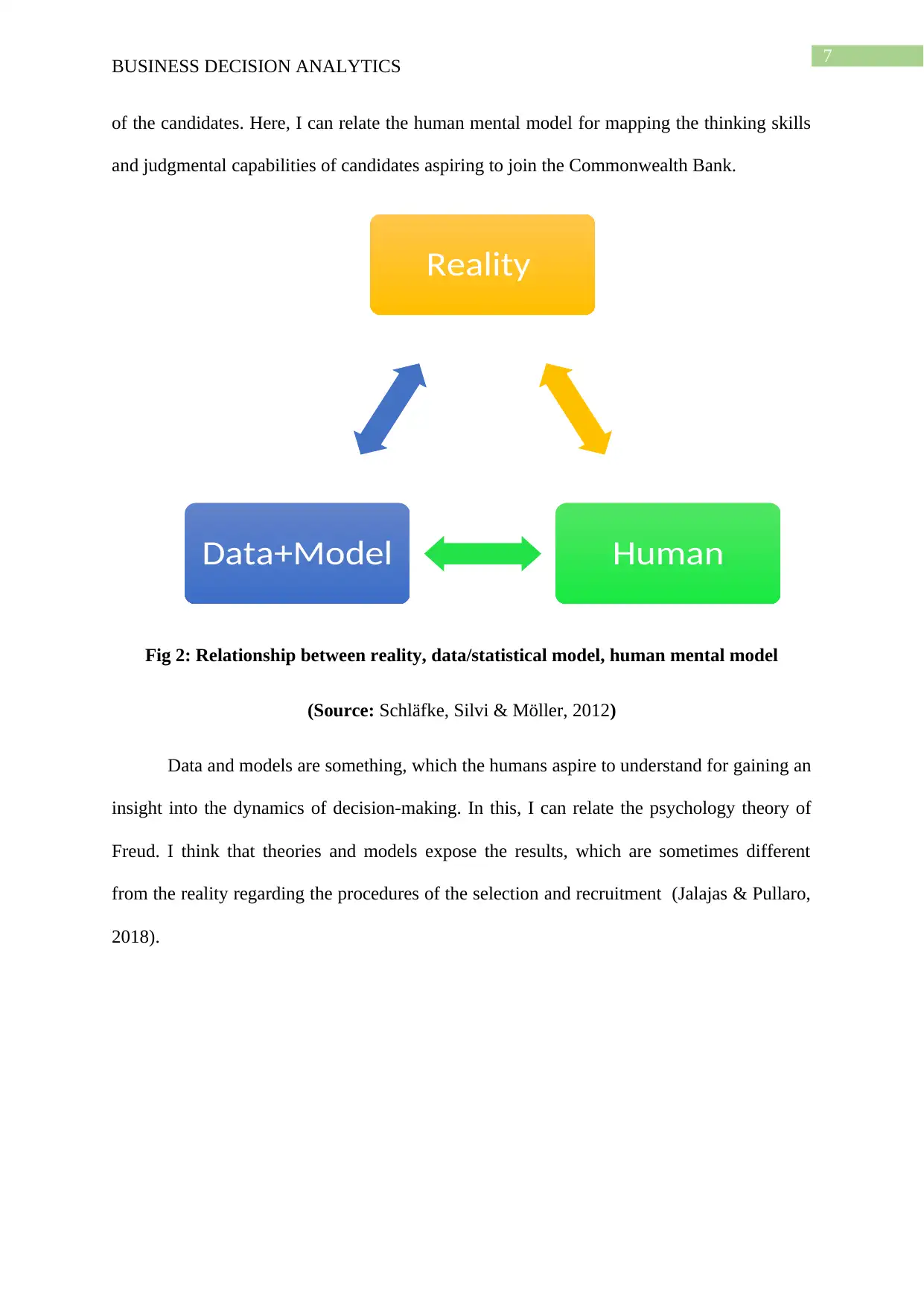
7
BUSINESS DECISION ANALYTICS
of the candidates. Here, I can relate the human mental model for mapping the thinking skills
and judgmental capabilities of candidates aspiring to join the Commonwealth Bank.
Fig 2: Relationship between reality, data/statistical model, human mental model
(Source: Schläfke, Silvi & Möller, 2012)
Data and models are something, which the humans aspire to understand for gaining an
insight into the dynamics of decision-making. In this, I can relate the psychology theory of
Freud. I think that theories and models expose the results, which are sometimes different
from the reality regarding the procedures of the selection and recruitment (Jalajas & Pullaro,
2018).
Reality
HumanData+Model
BUSINESS DECISION ANALYTICS
of the candidates. Here, I can relate the human mental model for mapping the thinking skills
and judgmental capabilities of candidates aspiring to join the Commonwealth Bank.
Fig 2: Relationship between reality, data/statistical model, human mental model
(Source: Schläfke, Silvi & Möller, 2012)
Data and models are something, which the humans aspire to understand for gaining an
insight into the dynamics of decision-making. In this, I can relate the psychology theory of
Freud. I think that theories and models expose the results, which are sometimes different
from the reality regarding the procedures of the selection and recruitment (Jalajas & Pullaro,
2018).
Reality
HumanData+Model
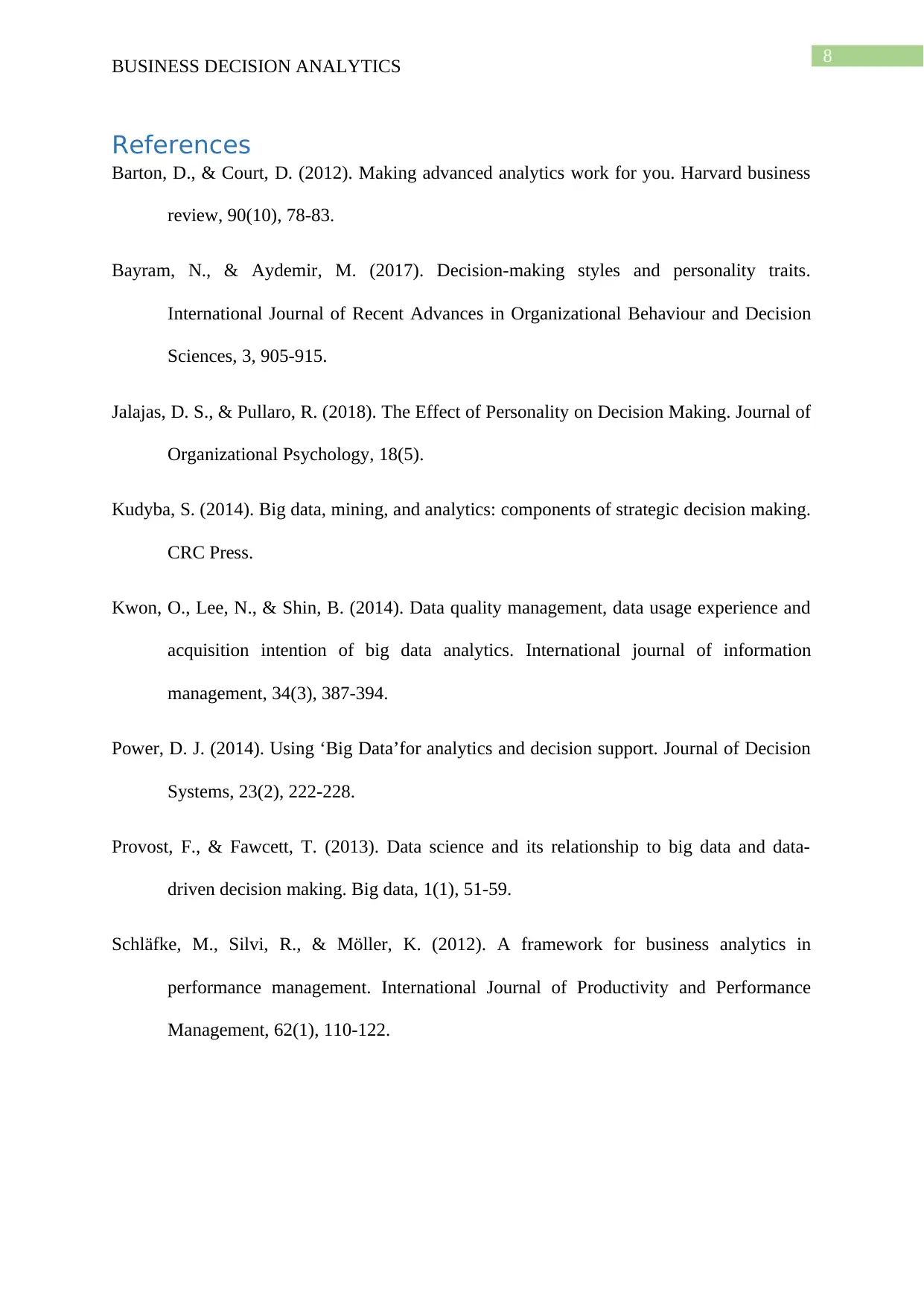
8
BUSINESS DECISION ANALYTICS
References
Barton, D., & Court, D. (2012). Making advanced analytics work for you. Harvard business
review, 90(10), 78-83.
Bayram, N., & Aydemir, M. (2017). Decision-making styles and personality traits.
International Journal of Recent Advances in Organizational Behaviour and Decision
Sciences, 3, 905-915.
Jalajas, D. S., & Pullaro, R. (2018). The Effect of Personality on Decision Making. Journal of
Organizational Psychology, 18(5).
Kudyba, S. (2014). Big data, mining, and analytics: components of strategic decision making.
CRC Press.
Kwon, O., Lee, N., & Shin, B. (2014). Data quality management, data usage experience and
acquisition intention of big data analytics. International journal of information
management, 34(3), 387-394.
Power, D. J. (2014). Using ‘Big Data’for analytics and decision support. Journal of Decision
Systems, 23(2), 222-228.
Provost, F., & Fawcett, T. (2013). Data science and its relationship to big data and data-
driven decision making. Big data, 1(1), 51-59.
Schläfke, M., Silvi, R., & Möller, K. (2012). A framework for business analytics in
performance management. International Journal of Productivity and Performance
Management, 62(1), 110-122.
BUSINESS DECISION ANALYTICS
References
Barton, D., & Court, D. (2012). Making advanced analytics work for you. Harvard business
review, 90(10), 78-83.
Bayram, N., & Aydemir, M. (2017). Decision-making styles and personality traits.
International Journal of Recent Advances in Organizational Behaviour and Decision
Sciences, 3, 905-915.
Jalajas, D. S., & Pullaro, R. (2018). The Effect of Personality on Decision Making. Journal of
Organizational Psychology, 18(5).
Kudyba, S. (2014). Big data, mining, and analytics: components of strategic decision making.
CRC Press.
Kwon, O., Lee, N., & Shin, B. (2014). Data quality management, data usage experience and
acquisition intention of big data analytics. International journal of information
management, 34(3), 387-394.
Power, D. J. (2014). Using ‘Big Data’for analytics and decision support. Journal of Decision
Systems, 23(2), 222-228.
Provost, F., & Fawcett, T. (2013). Data science and its relationship to big data and data-
driven decision making. Big data, 1(1), 51-59.
Schläfke, M., Silvi, R., & Möller, K. (2012). A framework for business analytics in
performance management. International Journal of Productivity and Performance
Management, 62(1), 110-122.
⊘ This is a preview!⊘
Do you want full access?
Subscribe today to unlock all pages.

Trusted by 1+ million students worldwide
1 out of 9
Related Documents
Your All-in-One AI-Powered Toolkit for Academic Success.
+13062052269
info@desklib.com
Available 24*7 on WhatsApp / Email
![[object Object]](/_next/static/media/star-bottom.7253800d.svg)
Unlock your academic potential
Copyright © 2020–2025 A2Z Services. All Rights Reserved. Developed and managed by ZUCOL.



